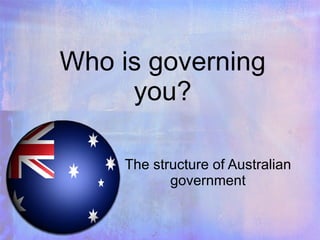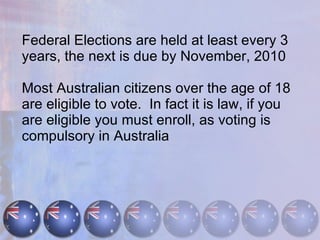Australian Governments
- 1. Who is governing you? The structure of Australian government
- 2. Australia is ruled by democratically elected governments and councils
- 3. What is a democracy?
- 4. What governments rule in Australia and what do they rule?
- 5. There are 3 levels of elected government in Australia: 1. Commonwealth 2. State 3. Local Councils
- 6. Commonwealth Parliament has the power to make laws for all Australians
- 7. The Commonwealth Parliament consists of: 1. British Monarch (Queen) 2. Governor General ( Ms Quentin Bryce AC) 3. Two Houses of Government The Upper House (Senate) The Lower House ( House of Representatives)
- 8. What do the two Houses of government do?
- 9. The Senate is often referred to as the âHouse of the Statesâ. It allows equal representation of the states regardless of population. The Senate consists of 76 members, 12 from each of the six states, and 2each from the Australian Capital Territory and the Northern Territory.
- 10. The House of Representatives is often referred to as the âHouse of Governmentâ. This is because the party that holds the most seats in the House of Representatives governs. The House of Representatives has 150 members
- 11. Any proposed law changes, known as Bills, have to be passed in both Houses and agreed to by the Governor General before they can become laws or Acts of Parliament.
- 12. Ėý
- 13. The Federal government is broadly responsible for: Taxation and Economic matters National Security Foreign Affairs Welfare Communication
- 14. Federal Elections are held at least every 3 years, the next is due by November, 2010 Most Australian citizens over the age of 18 are eligible to vote. In fact it is law, if you are eligible you must enroll, as voting is compulsory in Australia
- 15. Each State and Territory has its own Government and Parliament
- 16. Most of them have two houses like the Commonwealth Government 1. Legislative Council (like the Senate) 2. Legislative Assembly (like the House of Representatives) Queensland and the Northern Territory have just the one, the Legislative Assembly
- 17. For laws to be passed in the States they must go through the same process as they do for the Commonwealth Government
- 18. State elections are held every 4 years and also have compulsory voting
- 19. The States are largely responsible for: Health Education Policing
- 20. Local Government or Councils (In Queensland) were established to provide support and representation for the Commonwealth and State Governments on a local level.
- 21. There are 73 regional councils in Queensland, represented by 553 councillors, of which 73 are Mayors. Council elections are held every 4 years
- 22. Regional councils are largely responsible for community needs such as: Waste/Rubbish collection Public Recreational facilities (pools, parks etc.) Town Planning
- 23. References: Internet: http://www.indezine.com/ http:// en.wikipedia.org /wiki/Democracy http://www.parliament.curriculum.edu.au/comm.htm http://www.gg.gov.au/governorgeneral/category.php?id=2 http://www.ourcommunity.com.au/advocacy/advocacy_article.jsp?articleId=2404 Government in Australia (2003). [Online], Available: www.kidcyber.com.au http://en.wikipedia.org/wiki/File:Legislative_Process_in_Australia_flowchart.png http://www.qld.gov.au/government/system-of-government.html http://www.dip.qld.gov.au/about-local-government-and-councils/index.php http://www.itsanhonour.gov.au/symbols/anthem.cfm#download http://www.wikihow.com/Embed-YouTube-Flash-Videos-in-Your-PowerPoint-Presentations http://www.youtube.com/watch?v=Arn8Fp1jyok
- 24. Copyright, Concept & Creation: Geetesh Bajaj






















![References: Internet: http://www.indezine.com/ http:// en.wikipedia.org /wiki/Democracy http://www.parliament.curriculum.edu.au/comm.htm http://www.gg.gov.au/governorgeneral/category.php?id=2 http://www.ourcommunity.com.au/advocacy/advocacy_article.jsp?articleId=2404 Government in Australia (2003). [Online], Available: www.kidcyber.com.au http://en.wikipedia.org/wiki/File:Legislative_Process_in_Australia_flowchart.png http://www.qld.gov.au/government/system-of-government.html http://www.dip.qld.gov.au/about-local-government-and-councils/index.php http://www.itsanhonour.gov.au/symbols/anthem.cfm#download http://www.wikihow.com/Embed-YouTube-Flash-Videos-in-Your-PowerPoint-Presentations http://www.youtube.com/watch?v=Arn8Fp1jyok](https://image.slidesharecdn.com/australiangovernments-100411230941-phpapp02/85/Australian-Governments-23-320.jpg)
